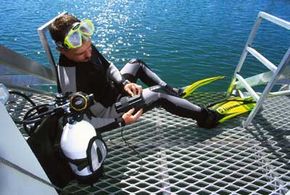
Through various concoctions and customs, humans have found ways to keep mosquitoes from biting, deer from destroying gardens and even bears from tearing campsites into pieces. But we have yet to create a surefire safeguard against sharks.
Various companies have tried out specialized sunscreens, chemical sprays, visual tricks and disguises, with little documented success. Then, in 2005, scientists accidently discovered something far simpler -- something that sent sharks swimming away from it like people running from a burning building.
Advertisement
During experiments at the Bimini Biological Research Station in the Bahamas, researchers Eric Stroud and Michael Hermann, with the company SharkDefense, dropped a small magnet in the water beside a shark. The presence of the magnet elicited a distinct reaction from the fish -- they darted away from it. To determine the strength of this repugnant force, Stroud and Herrmann held sharks on their backs, inducing a condition called tonic immobility, or a temporary paralysis that naturally occurs when the fish lay in that position. Sure enough, the magnets jolted the sharks into action [source: Stroud].
Why the intense reaction? The interaction of salt water and charged metals produces a weak electrical field. When a shark comes close to that field, the field seems to disrupt the sharks' special sixth sense, electroreception. Many shark species have pores dotted around their snouts called ampullae of Lorenzini that detect minute changes of electricity in the seawater, up to one-billionth of a volt. These electrical impulses come from the tiniest muscle contractions of other aquatic life forms -- or people -- and are carried through the ions in the salt water. For more detailed information on electroreception, read What is electroreception and how do sharks use it?.
Does this mean that we should toss a couple of magnets in our beach bags and splash away with nary a care in shark-infested oceans? Find out the answer on the next page.
Advertisement

